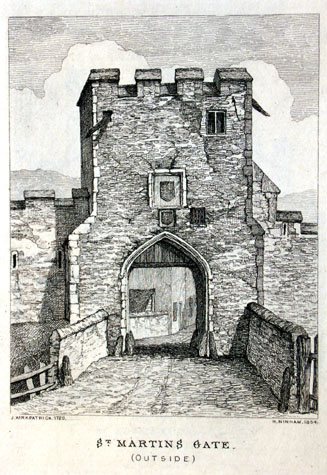
[1] The outside of the gate from the north.
The illustration was produced by H Ninham in 1864, based on a sketch of 1720
by John Kirkpatrick. [Norwich Castle Museum and Art Gallery 1954.138, Todd
5, Norwich, 112a]
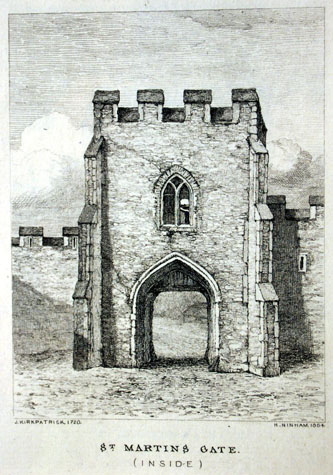
[2] View of the inside of St Martin's Gate
about 1720 engraved by Henry Ninham from the drawing by John Kirkpatrick.
[Norwich Castle Museum and Art Gallery 1954.138, Todd 5, Norwich, 112b]
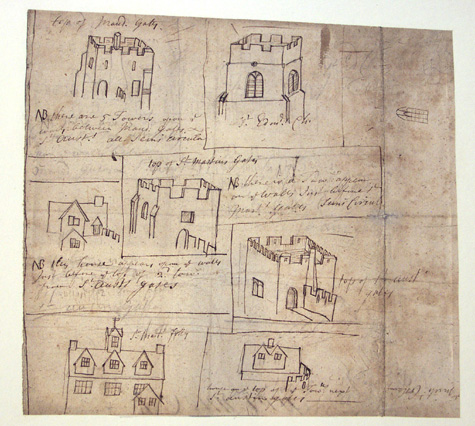
[3] Detail of Kirkpatrick's sketch of the
gate about 1730. [Norwich Castle Museum and Art Gallery
1894.76.1686:F]
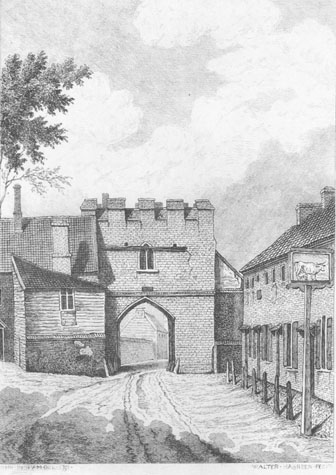
[4] View of the outside of the gateway in
1791 by John Ninham published by Fitch in 1861.
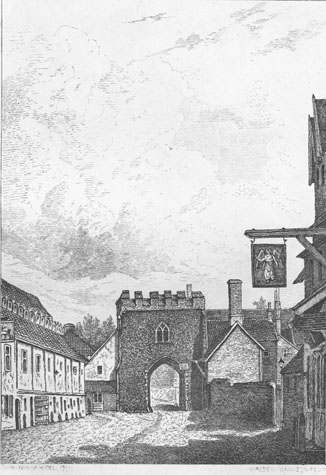
[5] View of the inside of the gateway in
1791 by John Ninham published by Fitch.
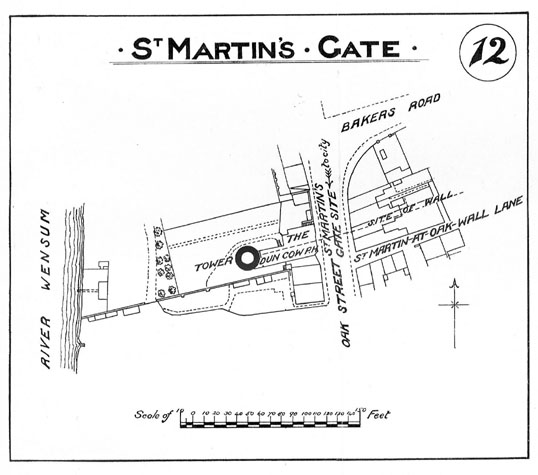
[6] Map of the site of the gate published in
1910 in the report by A Collins.
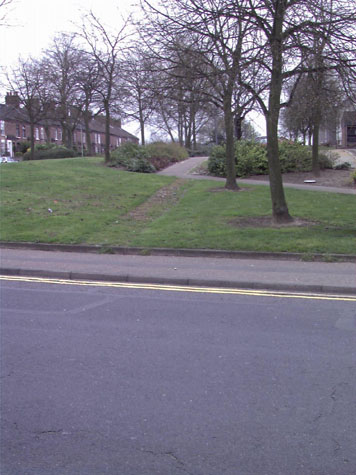
[7] View looking east across Oak Street,
across the site of the gate. The modern cobbles on the grass verge
mark the approximate line of the wall along Baker's Road.
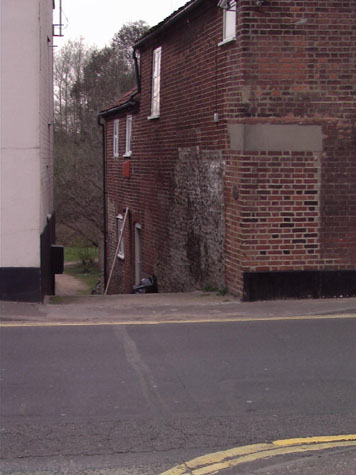
[8] View looking west across Oak Street,
across the site of the gate. The lower part of the wall to the west of
the gate survives in the cellar of the former Dun Cow pub, the house on the
right. The narrow lane between the houses leads down on the line of
the lane inside the wall to the Oak Street tower and the river.
|
General Description
John Kirkpatrick's drawings of the inside
and outside of the gate in 1720 [NCM Todd Collection, vol. II, box 5, page
112c] were engraved by Henry Ninham in 1864. [1 & 2]
These
show corner buttresses on both sides, running out parallel to the wall on
the front and angled buttresses on the inside. The upper chamber was
lit by a two-light window with Y-shaped tracery towards the street and this
was probably original. On the outside was a central square coat of
arms over the archway and a small two-light window set high up and off set
to the west. This probably indicates the position of an internal vice
at the north-west corner of the gateway to give access to the roof from the
upper chamber.
A rainwater spout, set well below the top of
the battlement, implies that at that time, the roof of the upper chamber was
set down behind tall parapets.
The outer archway was tightly flanked by the
high parapet walls of the bridge over the ditch. On the west side of
the gate is shown a steeply raked parapet protecting the steps down from the
upper chamber on to the wall walk to the west. The walk to the east is
shown at a higher level.
Kirkpatrick's undated pen and ink sketch of
the upper part of the gateway from the east [Norwich Castle Museum
1894.76.1686: F] shows that there was a single merlon at the centre of each
of the sides. [3] He drew a round-headed doorway onto the wall walk on
the east side with a square window above it. An inscription on the
sketch is as follows: 'NB there is a Tower appears on the walls just before
St. Martin's Gates seems circular.'
Seventy years later, John Ninham's drawing
of the outside [NCM Fitch Collection 1769.76.94] shows the gate apparently
complete, faced entirely (or repaired?) with brick. [4] A small flint
section of the wall without battlements is visible immediately to the right
of the gate, while two buildings abutting the wall and gates to the left,
obscure the wall on that side. A public house with the sign of a cow appears
to be built against or very close to the wall at the right or west side. The
public house here was called the Dun Cow in the 19th century and the present
house on this site is called the Old Dun Cow.
Ninham's view of the gate from inside the
city [NCM Fitch Collection 1770.76.94] shows complete battlements made from
brick, and the gate itself is shown as apparently complete with no eroded
flint work. [5] Presumably this reflects the repairs ten years
previously. (see below) There are buildings against both sides of the
gateway so the wall is not visible to the left or right. Abutting the gate
on the left, or west and parallel to the line of the wall is a small
dwelling. The long outshut roof of this building against the west side
of the tower could cover the steps up from the wall walk and may suggest
that the cottage incorporated the upper chamber of the tower. On the
right side of the gate more dwelling houses appear parallel to the wall
line, adjoining the building (public house?) at right angles to the gate.
Documentary evidence
The account of the works on the walls
completed at the expense of Richard Spynk in the five years up to 1343 were
transcribed and published by Hudson and Tingey. [Extract from
The Old
Free Book, Hudson & Tingey, Vol. II, pages 216-22] The short
description in that document gives a clear picture of the gate and the work
required to improve and strengthen the defences in this part of the city.
'Between the gate of
Coselany and the river was a low ill conditioned place to work at, and the
community would only assign for the said place �13 of costs, and the said
Richard took to himself the money of the community and had work done at his
order, which cost quite 50 marks or more. And the said gate of
Coselany and the portcullis with machinery, and the gate covered with
timber, board and lead, and bars and chains at the entrance.'
The last leaf of the Book of Customs states
that in 1377 'From the river to Coslany or St. Martin at the oak gate, are
112 battlements, and 10 upon that gate, and from thence in the walls and
towers to St. Austin's gate are 69 battlements.' [cited by Blomefield,
page 98] Given that elsewhere on the walls the individual merlons are
up to 2 metres wide and the distance from the tower to the gate was only
about 26 metres the number of crenellations given must either be a mistake
or a mis transcription.
The Agistment for the Walls for repairs from
1451 and 1481 shows that Coslany ward was responsible for repairs to 'the
tower on the north side of the river, with the walls, to Coslany or St.
Martin's gate, the walls and towers to St. Augustine's gates, and both
those gates.' [Liber Albus f. 177; Hudson & Tingey Vol. II, pages
313-15]
In 1460 three soldiers were kept on guard at
the gate, and in 1643, along with other precautions during the Civil War,
the gates were rampired up with earth.
About 1711, Kirkpatrick recorded that there
were two inscriptions on the gate relating to repairs in 1680 and 1699.
[Collins 1910, page 47 not quoting the source]
The Tonnage Book for 1757 ordered that the
gate was to be plastered, and this coloured, while in 1760 the gate was
rebuilt under the direction of Robert Rogers and John Black. [Tonnage Books,
N.R.O. NCR Case 19 shelf C; cited by Fitch, page24]
Map evidence
Kirkpatrick's map of the early 18th century
shows the gateway and the flanking walls still free of buildings. The
wall to the west is shown as relatively short, running down to a single
round tower where the defences terminated. [See Report 13] At
that time the tower was on the bank of a narrow channel with a long narrow
island between this channel and the main river.
Hochstetter's map of 1789 seems to indicate
that the gate was set back with the front of the gate almost level with the
line of the wall. Elsewhere the gates tend to project forward towards
or even over the bridge before the gate. In 1789 there were still few
buildings around the gate and the line of the lane inside the wall was still
open.
A sketch map of the site of the gate,
published in the report of 1910, shows the houses built in the 19th century
on either side of Oak Street tightly around the site of the gateway. [6]
Present setting
The site of the gateway is under Oak Street and there is nothing here to
indicate its position although the line of the wall east of the gate is
marked in cobbles. An information panel could be erected here with a
discrete sign marking the steps down to Oak Street tower west of the gate.
[7 & 8]
BIBLIOGRAPHY:
Blomefield, Francis, An Essay Towards the Topographical History of
the
County of Norfolk, vol. III: The History and County of Norwich Part I
(London: W. Bulmer, 1806)
Fitch, Robert, Views of the Gates of Norwich made in the years 1792-3 by
the Late John Ninham (Norwich: Cundall, Miller, and Leavins, 1861)
Hudson, William, and Tingey, John C., The Records of the City of Norwich,
vol. II (Norwich & London: Jarrold & Sons, 1910)
DOCUMENTARY REFERENCES:
N.R.O. Book of Customs (last leaf)
N.R.O. MF/RO 29/3 f. 177 (Liber Albus)
N.R.O. NCR Case 19 Shelf C (Tonnage Books, 1720-1836)
See also:
Buckler, J., 'St. Martin's Gate in the Distance St. Laurence',
NCM
1941.12.4:INT
Collins, Arthur E., The Walls of Norwich (City and County of Norwich,
Norwich: Jarrold & Sons, 1910)
Pococke, Edward, 'Sixteen Drawings of the Gates of Norwich', NCM
1955.219:IN
HISTORIC ILLUSTRATIONS IN THE DATABASE:
From the Castle Museum and Art Gallery:
Kirkpatrick, John, NCM 1894.76.1686:INT, 'Various Gates and Houses'
Ninham, Henry, from John Kirkpatrick, 'St. Martin's Gate' NCM Todd
Collection, vol. II, box 5, page 112c
Ninham, John, 'St. Martin's Gate, Outside' NCM Fitch Collection
1769.76.94
Ninham, John, 'St. Martin's Gate, Inside' NCM Fitch Collection
1770.76.94
|
